We are on a road trip to North Carolina for a week, visiting the Outer Banks. Here are a few shots from today:
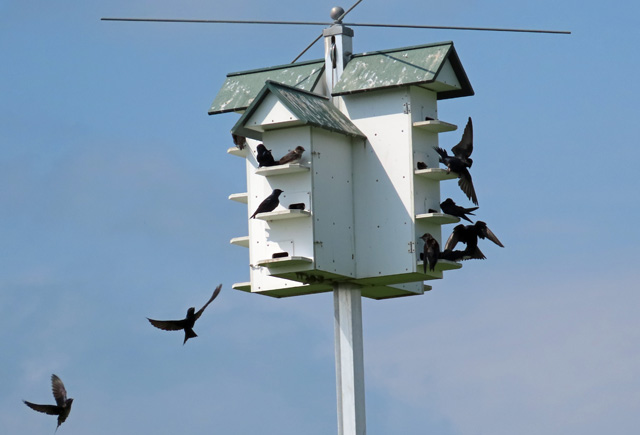
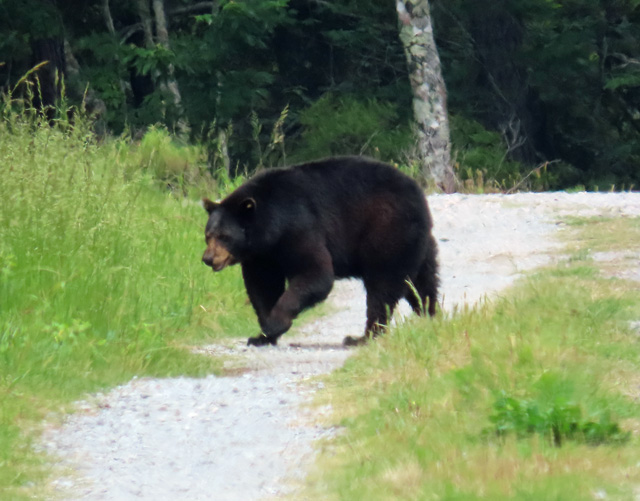
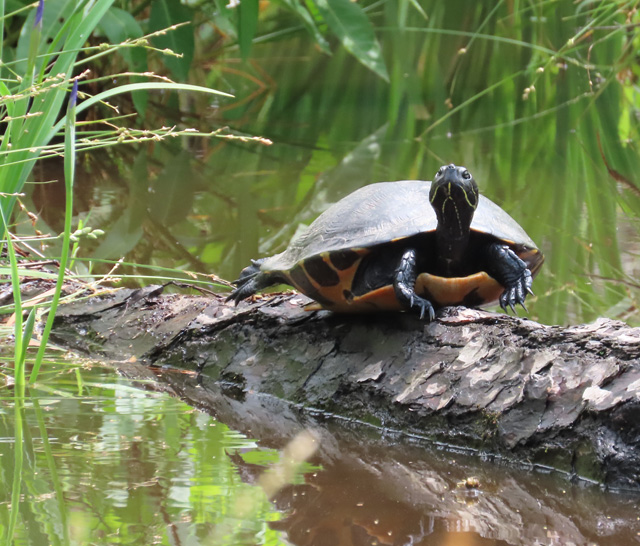

We are on a road trip to North Carolina for a week, visiting the Outer Banks. Here are a few shots from today:



One of the "must-do" trips when we are a Goose Island State Park is to get to the [Aransas National Wildlife Refuge](http://www.vtbirder.com/aransas-national-wildlife-area/) so we loaded up some lunch, our birding gear, and the dog and headed out yesterday morning. It’s only a short trip, much of it at 70 mph, and it is always a bit unreal to take the narrow roads through cotton country. The fields are continuous black soil, flat as can be, cut only by irrigation ditches. Way off, like mirages on a desert, trucks float along just on the horizon. It’s about as far removed from Vermont as possible.
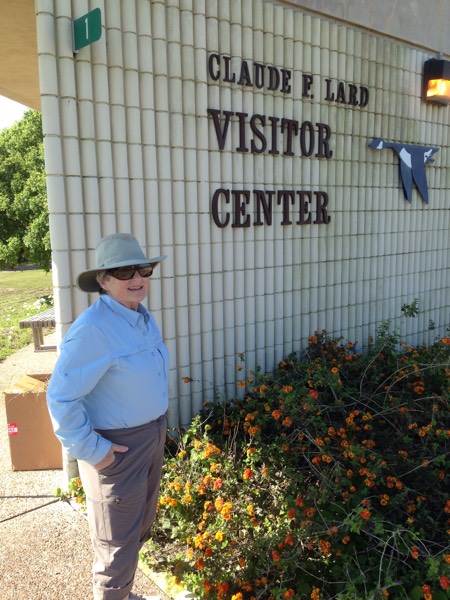
The refuge is large and being remote, not that busy, even on a weekend. Mary and I get in free with our Senior Pass (one benefit of getting old) and there is a pretty driving loop along the coastline with several overlooks.
The first stop after the impressive visitors’ center is the alligator viewing pond. They’ve constructed a new viewing platform and right below it was this young alligator, taking the sun. It’s Mary’s type of alligator viewing – there’s no way, unless he sprouts wings, that he’s going to bother her.
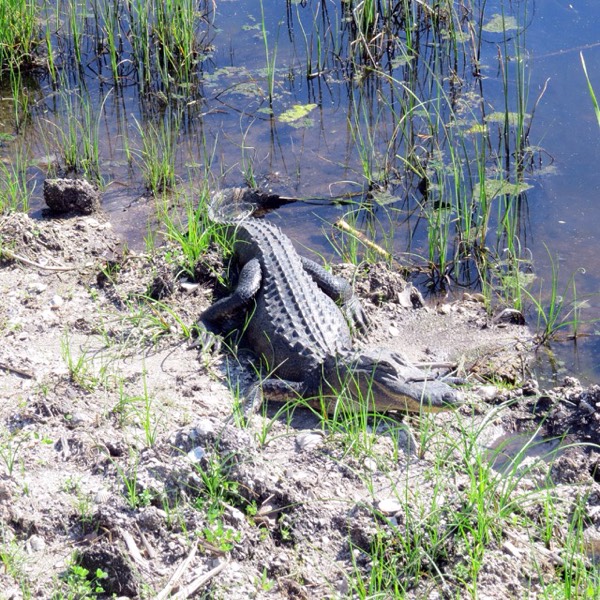
The birding was so-so with the exception of Scissor-tailed Flycatchers, who have just begun to show up. Some will stay here, others will continue their migration northward. There were over a dozen and all were having trouble perching in the stiff breeze. This one balanced on a sign.
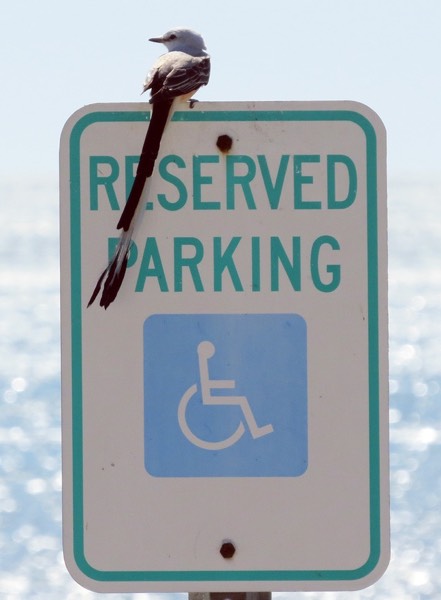
As did this one.
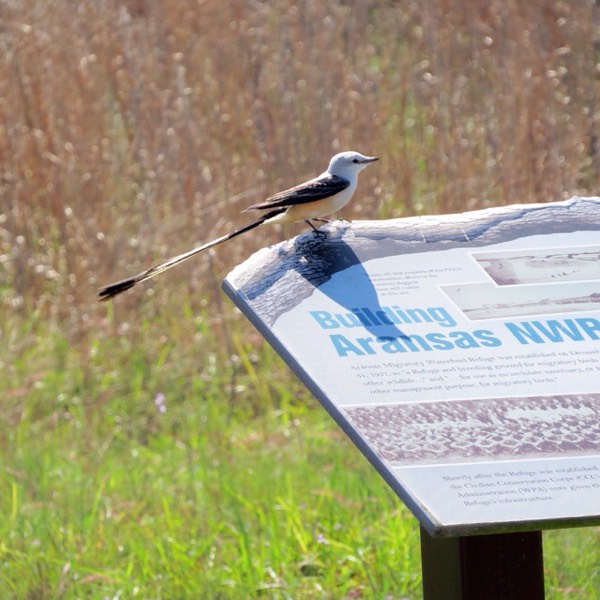
Later, after seeing a couple of Whooping Cranes from the elevated platform, I thought I saw a bunch of white birds way up high. I tried to get my binoculars on them with no luck, finally giving up. I told Mary that I must have mistaken a swarm of insects for a flight of birds.
We moved on, driving the long scenic loop, when I thought I saw a similar group of white objects. I stopped the truck and realized right away that they were birds that showed up when the sun was on them but disappeared when they turned away. They were making large circles, thermalling and drifting with the wind. I got Mary on them and through the binoculars, could see that they were White Ibis. My camera didn’t focus well but you can get a sense of the neat swirling birds we were seeing.
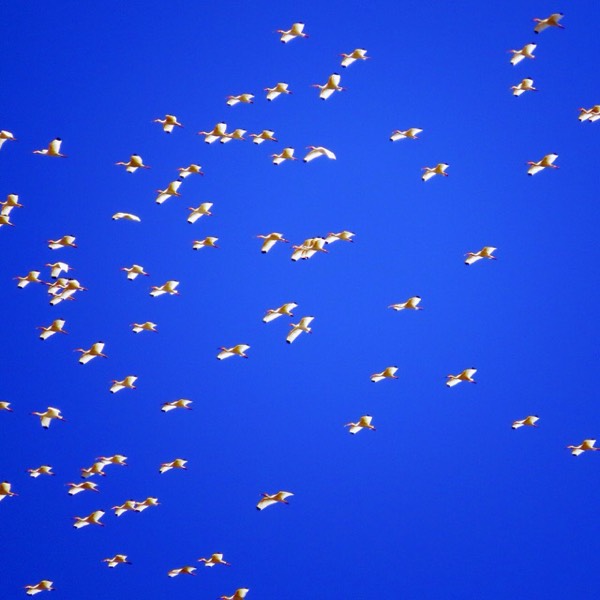
The temperature showed 80 as we stopped in a grove overlooking the water. The wind, while making casual dining a workout, kept the bugs (which were there) away. It was a nice Saturday morning in southern Texas.
During our stays at Goose Island State Park outside Rockport, TX, we always try to make a visit to Aransas National Wildlife Area which is about a 35 mile drive. Aransas NWA is famous as the winter home of Whooping Cranes (although we have had much better luck near Goose Island State Park, on 8th avenue near the Big Tree where there are feeders in several pastures). Aransas is just a wonderful place to visit for birds and wildlife.
I remember our first visit: it was tension-filled because I had headed out with probably a half-tank of gas in the truck and you know how that goes – the second half seems to go a lot faster than the first. It is a Texas-flat drive. I don’t think we changed elevation more than ten feet the whole way – that to cross streams – and most of it was straight as an arrow. Massive black dirt field lie in wait of spring planting — and way across them, you could see cars and trucks moving like mirages. We cut that trip a bit short due to the gas situation — there’s nothing out there.
The roads in from Highway 35 are narrow farm roads and the signage is a little weak, at least the first time you drive it. It’s a lot further in than an Easterner might expect – it seems to go on forever — like much of Texas driving. As mentioned, there are very few gas stations or places to eat nearby, so plan accordingly. The Visitor Center (pay here for admission to the park–$5/car) is very nice with exhibits, a short film, gift shop and restrooms. We found the volunteers really friendly and helpful – like many federal parks and areas, the volunteer help makes the operations run.
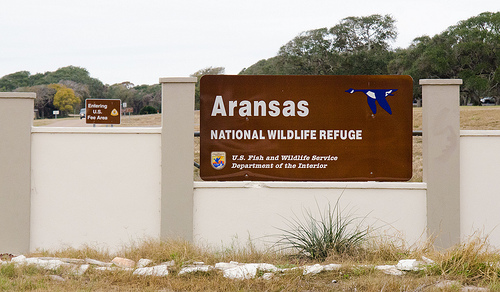
Ringed by tidal marshes and broken by long, narrow sloughs, this 59,000-acres refuge sprawls mostly across the Blackjack peninsula.
Mild winters, plentiful water, and an abundant food supply attract more than 400 species of birds throughout the year. While the Whooping Crane is undoubtedly the highlight of the winter months, other water birds including Reddish Egret, White and White-faced Ibis, Mottled Duck, and Purple Gallinule also feed in the rich bay and the fresh-water lagoons further inland. In migration, the oak woods provide critical habitat for neotropical migrants traveling the Central Flyway. The sandy prairies and scrublands are hunting grounds for White-tailed Hawk, Crested Caracara, Aplomado Falcon, and other raptors. Rare treats like Buff-bellied Hummingbird, Masked Duck, Painted Redstart, and other surprise visitors from southern climes are always a possibility.
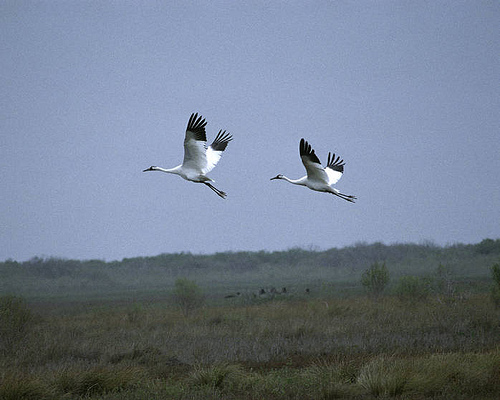
Whooping Cranes are one of the attractions but they are often far out and require a spotting scope. Many birders take boat tours out of Rockport for better looks.
Take the 16 mile driving loop, stop at overlooks and observation towers, plan several hours at least, and you will likely see deer, javelinas, raccoons, even alligators.
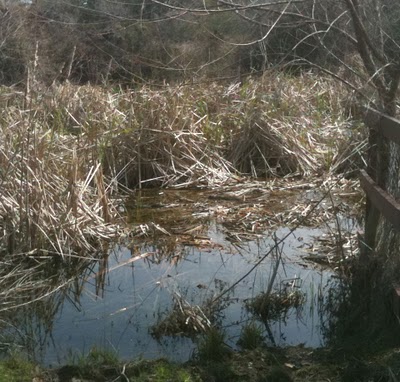
There is a alligator-viewing pool just outside the visitor center. There are several, just partially surfaced, here in this shot I took during a visit.
Unfortunately, the drought of the last several years has really affected the wildlife. Changing salinity levels have dropped the population of blue crabs, a primary food source for Whoopers, and some special feed has had to be trucked in during difficult periods. So you never know what you’ll see — but our visits in the last few years have been disappointing.
Most birders don’t make the NWA a destination per se — they are in the area for many of the other rich birding sites all along the coast and weave a trip here into their itinerary. Check locally — last time we were there, their was a reliable Burrowing Owl not far from the turn of the main highway and also several Scissor-tailed Flycatchers on fences just to the north of the area. Give it a shot — take your bike for some nice level riding with little traffic — just make sure you can out-pedal a javelina.
How to get there
From the south: Follow Hwy. 35N to the FM 774 exit. Turn right on FM 774 and go approx. 6 miles, winding through the farm fields. Turn right again on FM 2040. Go another 6 miles to the Refuge gate. Go to the Visitor Center to register.
From the north: Travel south on Hwy. 35 to Tivoli. Continue past Tivoli for approx. 1 mile to the FM 239 exit (on your left). Follow FM 239 to Austwell. Upon entering Austwell, FM 239 turns into FM 774 at the curve. Continue on FM 774. Follow 774 & take a right at the stop sign. Go down the end of the street. Take a right again. As you exit Austwell, drive ½ mile to the FM 2040 intersection. Go left on FM 2040 for about 6 miles to the Refuge gate. Go to the Visitor Center to register.
One of my favorite birding haunts is on Plum Island, Newburyport, MA. The Parker River National Wildlife Refuge is a prime Atlantic coast habitat for more than 300 species of birds. Our daughter and her family live less than an hour away so whenever we visit, I try to get over and check out the situation. The only problem is that dogs are not allowed at all and so it’s a hassle at times to find ways to leave Penny elsewhere. Like all refuges, a Senior Pass or a Federal Duck Stamp gets you in free.
I like to do some homework before I visit and one of the best sources is Tom Wetmore, who visits the refuge nearly every morning and keeps detailed records on his website. He has a wonderful “A Birder’s Guide to the Parker River NWR and Sandy Point SR on Plum Island” that you should download and print.
You can grab some of the same information from eBird but Tom tends to personalize it — and he often sees many notable birds first. The issue with eBird is that there are dozens of hotspots along the island so you need to check numerous sites. Here’s a map of some of the spots:
Parker River Refuge has a number of accessible sites and for someone unable to travel far, good birding in many spots along the access road. On a weekend, hundreds of slow-moving cars traverse the area although you have to watch out for folks heading to the state beaches at the end of island (outside the refuge). Some of them could care less for birds, or birders.
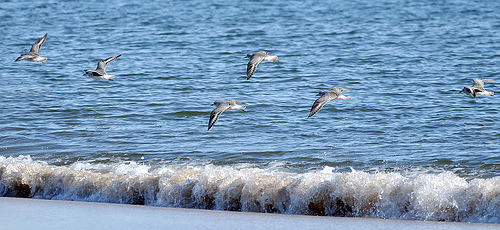
Hundreds of migratory shorebirds, waterfowl and songbirds use the salt marsh and freshwater impoundments. Shorebird migration begins in July, with numbers peaking in August. photos by USFWS -Northeast
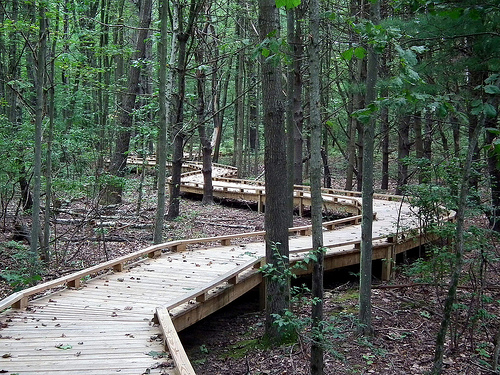
The Boardwalk near the Hellcat area is famous for warblers and songbirds. The birds are nearly at eye level. One end of the walk is the marsh/impoundments and the other, the ocean.
Peregrine falcons can be seen on the refuge from mid-September through November. In winter, the snowy owl returns – I saw my life bird there two years ago. Rough legged hawk and short eared owls can also be seen. Loons, grebes, scoters, and other waterfowl winter along the refuge shore.
Here’s how Tom Wetmore describes this neat spot:
If you are interested in only one specific group of birds you may be able to find a better spot in Massachusetts to see them, but if you are interested in finding the widest variety of birds from the widest variety of groups and on any day of the year there is no better spot to visit in the state than Plum Island.
Bird list: http://1.usa.gov/19zljMJ